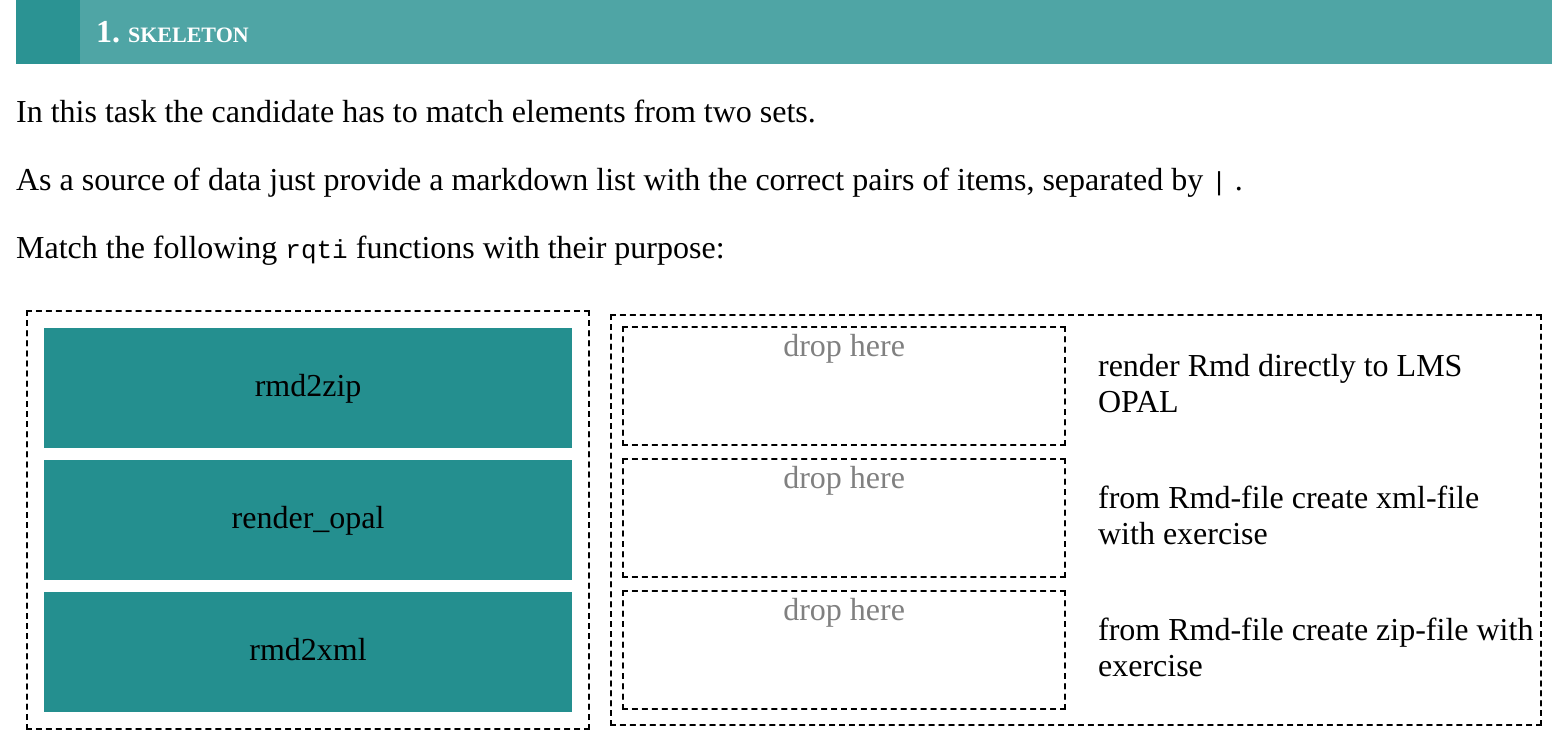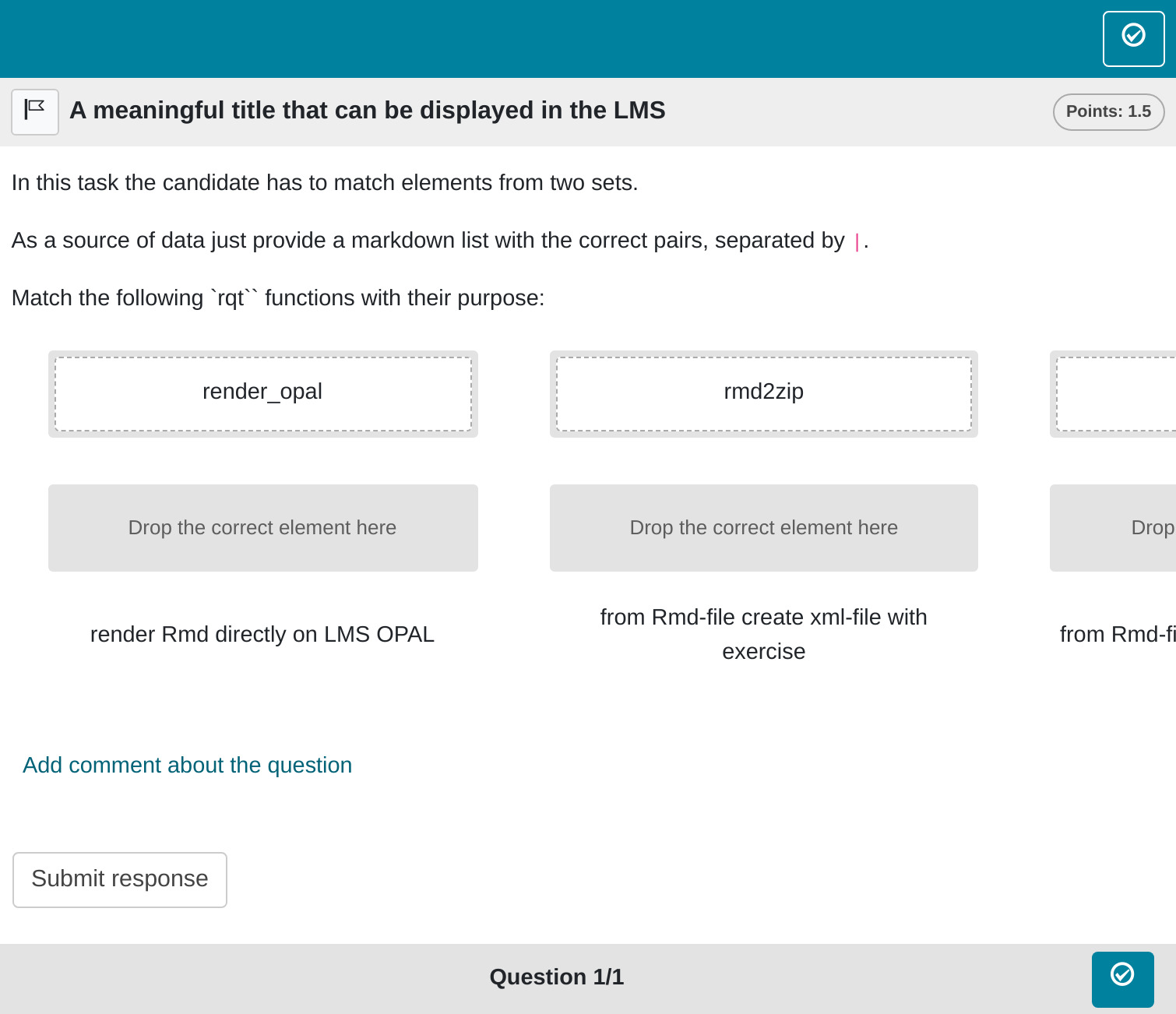Minimum version
In this type of task, the student is given two sets of items, which
need to be matched. A template is automatically created when you
initiate an rqti project through RStudio. Alternatively, it can be added
by clicking on
New file -> R Markdown -> From Template. The
rqti templates end with rqti. Here we look
at the templates directedpair (simple) and
directedpair (complex).
The minimum you need to provide is the type: pair (or
the equivalent type: dp) in the yaml-section and a list
with at least two elements in a section called
#question:
---
type: pair
knit: rqti::render_qtijs
---
# question
In this task the candidate has to match elements from two sets.
As a source of data just provide a markdown list with the correct pairs of
items, separated by `|`.
Match the following `rqti` functions with their purpose:
* rmd2zip | from Rmd-file create zip-file with exercise
* rmd2xml | from Rmd-file create xml-file with exercise
* render_opal | render Rmd directly to LMS OPAL
# feedback
Provide your feedback here.Knitting via the Knit-Button to qtijs, this task renders as:

The pairs are specified by a markdown list in which the matching
elements are separated by |. This list has to be the last
element of the question section!
An alternative is to provide a table task with the matching elements, see the article Tables.
Note that in the used example, a feedback section was also provided. The feedback is optional, but usually it is a good idea to give some explanation for students.
Note that the knit parameter is set to the custom rqti
knit function, which will handle the preview. Clicking the Knit button
in RStudio renders the file in the viewer pane. Alternatively, change
the knit parameter to knit: rqti::render_opal (see article
Working with the OPAL API) to upload to opal
directly, producing:

More control
If you want to have more fine-grained control, consider the RMD
template directedpair (complex), wich uses more yaml
attributes.
---
type: dp
knit: rqti::render_qtijs
identifier: TOPIC1_Q006 # think twice about this id for later data analysis!
title: A meaningful title that can be displayed in the LMS
orientation: horizontal # how items are placed on screen
shuffle: true # random order of elements
---
# question
In this task the candidate has to match elements from two sets.
As a source of data just provide a markdown list with the correct pairs,
separated by `|`.
Match the following `rqti` functions with their purpose:
* rmd2zip | from Rmd-file create zip-file with exercise
* rmd2xml | from Rmd-file create xml-file with exercise
* render_opal | render Rmd directly on LMS OPAL
# feedback
Provide your feedback here.
<!-- If you prefer specific feedback for correct and incorrect solution, delete
the general feedback section and uncomment everything starting from this line:
# feedback+
Nice. (Only displayed when the solution is correct.)
# feedback-
Try again. (Only displayed if the solution is not correct.)
-->In OPAL this renders as shown in the next image. The viewport is a bit too small to capture the entire task.

yaml attributes
identifier
This is the ID of the task, useful for later data analysis of results. The default is the file name. If you are doing extensive data analysis later on it makes sense to specify a meaningful identifier. In all other cases, the file name should be fine.
title
Title of the task. Can be displayed to students depending on the learning management system settings. Default is the file name.
shuffle
If true (the default), randomizes the order of the
elements. Only in rare occasions it makes sense to have a strict order
of elements (setting shuffle to false).
abbr_id
If abbr_id is not specified, rqti generates
the identifiers right_1, right_2, …
right_N and left_1, left_2, …
left_N. However, these lack inherent semantics. To enhance
clarity, some users might want to use the abbr_id
parameter, which introduces abbreviated identifiers based on the text of
the pairs. The utility of these abbreviations varies based on item
length, but they consistently offer more meaningful identifiers compared
to non-semantic alternatives.
Feedback
Feedback can be provided with the section
- # feedback (general feedback, displayed every time, without conditions)
- # feedback+ (only provided if student reaches all points)
- # feedback- (only provided if student does not reach all points)
Some advice on directed pair tasks
Directed pairs are forced choice tasks, so they have similar problems as single choice and multiple choice tasks (guessing). A specific problem of directed pairs is that answers are not independent. Making a mistake will lead to additional mistakes because two elements are blocked by one match. Use directed pairs with care.
One might think that directed pairs are superfluous because match tables serve the same purpose. The difference is that in match tables either the row or column can be used more than once. For directed pairs, matching a pair makes both elements unavailable for further matching. This is unique, so there are use cases for directed pairs. But it is important to note that match tables can also represent a direct pair, meaning both directed pairs and match tables can serve as interfaces to the same concept. However, match tables are generally more flexible and are often the preferred choice (refer to the article Table tasks for more details).